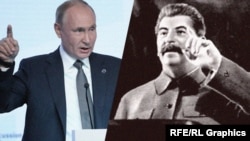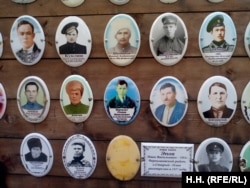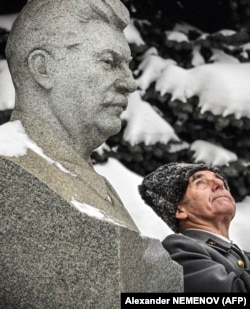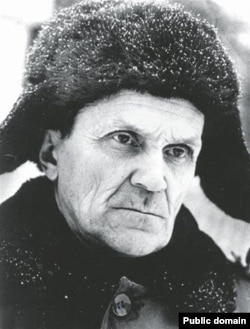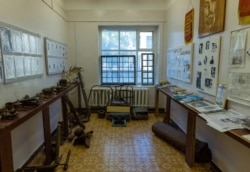In the second-largest city in Russia’s Tatarstan region, Naberezhnye Chelny, there is an unusual statue of Soviet dictator Josef Stalin on the grounds of an unlicensed private school.
Seated casually on a bench, the figure of Stalin leans into a conversation, inviting passersby to sit down and engage with him. By his posture and gesture, the tyrant seems simultaneously to be listening thoughtfully and patiently explaining something – a stark contrast to the brutal reality of his rule.
More than 100 monuments to Stalin can now be found across Russia, the majority of them erected over President Vladimir Putin’s 24 years in power. But the one in Naberezhnye Chelny may come closest to capturing the country’s paradoxical and ongoing interaction with a man who died 70 years ago but whose legacy continues to touch and even shape the lives of so many of its citizens. And key parts of that legacy are being manipulated by Putin’s Kremlin as it advances a statist, nationalist, militarized vision of Russia that many analysts say is effectively, if not ideologically, “neo-Stalinist.”
“In Russia today, ‘Lenin’ is just a figure in the mausoleum and in museums and nothing more,” wrote Leonid Nevzlin, a businessman who fled Russia for Israel in 2003 amid Putin’s takeover of the oil giant Yukos, in a 2020 essay for RFE/RL’s Russian Service.
“‘Stalin’ is our everyday reality. The Putin regime has a completely defined relationship to Stalin, to Stalinists, to Stalinism. This relationship is primarily tied to the roots of the regime. The KGB [and other Soviet security agencies] cannot be against ‘Stalin’ as an idea and as a practice. Stalin is their patron, their fate, and their biography.
“‘Stalin’ is a special operation under which the population is being drawn into the process of Stalinization and being recruited to become neo-Stalinists,” he wrote. “In the cultural-psychological sense, we remain a Stalinist society.”
Calling Stalin “the great manipulator,” Tatar activist and political analyst Ruslan Aisin wrote in an essay for RFE/RL’s Idel.Realities in August that Russia’s enduring inheritance from Stalin is one of subordination, conformity, individual isolation, and dislocation.
“We are definitely living inside Stalin’s legacy,” he wrote, “where the main things are fear, atomization, submission, and other social evils.”
'I Haven’t Heard Anything About It'
In 1991, career KGB officer Aleksei Solovyov was sent to the Far Eastern village of Smolenka to investigate archival evidence that victims of Stalinist repressions had been executed and dumped in mass graves in a local forest. It was part of the limited late Soviet and early post-Soviet efforts to expose the government’s crimes against the Soviet people under Stalin.
“We were walking slowly through the forest, speaking quietly among ourselves, when we noticed a depression in the ground under the melting snow,” Solovyov, now 92, told RFE/RL. “First, we counted eight of them, then nearly 20. In one depression, we found a bloody rabbit skin, apparently the victim of a fox. But we also found a bone that didn’t look like a rabbit’s. We sent it for examination, and it turned out to be human.”
Over the next few months, the team discovered 50 primitive mass graves with at least 2,500 remains of people unjustly executed in 1937-38. Experts estimate at least 8,000 people are buried in the forest, although research there stopped long ago.
According to Solovyov, the expedition’s roots went back to a conversation he had in 1980 with an elderly former officer of the Stalin-era security services whose identity he promised never to reveal.
“He looked sick and distressed,” Solovyov recalled. “What I heard was surprising and terrifying. He said he expected to die soon, and he needed to share this information and tell about those horrible events.”
The man, who had been a police sergeant in Stalin’s NKVD secret police, said he was summoned by an NKVD major and assigned to “carry out the sentences of enemies of the people.”
“‘We shot them in the prison every night, including holidays,’” Solovyov recalled the man telling him. Every night, the prison received an execution list signed by the head of the Chita regional NKVD, Grigory Khorkhorin. Khorkhorin was himself arrested in 1938 and died in custody in March 1939.
“Those condemned to death did not know their fate: The tribunals met secretly and didn’t announce their verdicts to the defendants,” Solovyov said. “The guards escorted the condemned to the basement,” where they were “shot in the back of the head with a revolver.”
“The [former NKVD officer] couldn’t tell me where the bodies were buried,” he added. “He didn’t know.”
Today, there is a small, informal memorial in the forest with the names of some of the victims who were buried there. But few locals know much about it.
“I heard there is a memorial,” Yelena Sedova, a resident of Smolenka, a settlement of some 10,000 people about 15 kilometers north of Chita, said. “But I have never been there.”
A 22-year-old local man who asked that his name be withheld said he knew nothing of the site in the forest.
“I didn’t know there is a memorial where someone was buried,” he told RFE/RL. “Repressed people? They shot people here? Go figure. I haven’t heard anything about it.”
Despite his chilling experience looking into the eyes of the broken NKVD executioner and investigating the Smolenka mass graves, Solovyov welcomes the present-day rehabilitation of Stalin.
“Stalin was a wise politician in his day, and those who criticize him just want to tarnish the ideas of communism and our great past,” he said. “Only those who want to distract Russian citizens from the serious failures of the [post-Soviet] reforms need de-Stalinization. The people don’t need it.
“The repressions were a terrible page in our history,” he conceded. “But any regime has its mistakes and dark spots. We need to talk about all the good things that happened under Stalin. And there were a lot of them. Although you could say the state at that time was built on the labor of the repressed, sometimes you need to make sacrifices to achieve certain goals.”
Oleg Yachmenev is a history graduate student at Zabaikal State University in Chita. Many of his instructors, he said, are “active Putinists.” He recalls discussing Stalin’s crimes with one lecturer who in the end said that “although things were bad, it would have been worse otherwise.”
“Unfortunately, it has become the norm to praise the Stalin era because people don’t know the truth about the camps and the repressions,” Yachmenev said. “Now, if I want to get information about those who were executed and I go to the archives, people in epaulets soon appear asking if I am a ‘foreign agent’ who is trying to smear Stalin, the pride of Russia.”
Respect And Fear
The rehabilitation of Stalin has been a feature of the Putin era since the former KGB officer came to power nearly a quarter-century ago. The independent Levada Center polling agency began asking Russians to name “the greatest figure of all times and peoples” in the early 1990s. In 1994, the Soviet dictator polled about 20 percent to take a distant fourth place in the ranking. By 2012, however, he took over first place, a position he has held ever since. By 2021, Stalin was the pick of more than 40 percent of Russians. In 2023, 47 percent of Russians said they regarded Stalin with “respect.”
“‘Respect’ in modern language signifies a warm, sincere feeling but also a recognition of the superior power of the object of the respect,” wrote Levada Center chief analyst Aleksei Levinson in an essay in August. “‘They fear us, which means they respect us’ is commonly heard these days. And it crops up a lot among the responses to questions about Stalin.”
The Kremlin’s manipulation of Stalin’s image and of the psychological legacy of the Soviet experience for the Russian people has evolved since Putin first became president on the last day of 1999, observers say. In the early years, Stalin was promoted as an “effective manager” who led the Soviet Union to victory over Nazi Germany. His image was almost always tied to World War II, cropping up with increasing frequency on banners and posters illustrating the Putin government’s glorification of the Soviet role in the war.
Over time, however, the tight connection between Stalin and the war has been loosened, and Stalin and Stalinist imagery appeared in a much wider array of contexts -- from advertising to the arts. He features prominently and positively in the dozens of jingoistic Russia: My History exhibitions the government has set up across the country.
In the glasnost era under the Soviet Union’s last leader, Mikhail Gorbachev, Stalin largely appeared only in the context of the condemnation of his crimes, as gruesome details emerged and became a topic of media conversation across the country. Now, analysts say, he has become fully normalized in the everyday lives of Russians.
“Stalin constantly appears in the public space,” Denis Volkov, the director of the Levada Center, told RFE/RL in a 2021 interview. “[Folklorist] Aleksandr Arkhipov has counted nearly 150 monuments. In part, these are grassroots initiatives. Sometimes, the Communist Party helps, but fundamentally it is grassroots Stalinism. Nostalgia for a chief, for a strong hand.”
Under Putin, Russia has reached a stage that can be described as “mature authoritarianism,” said biologist Ilya Kolmanovsky, who has created numerous science-education programs.
The effect on the public is that “society is not living its everyday life, but exists in a state of mobilization,” he said. “The state keeps people in a state of mobilization, under the threat of attack, which in turn justifies autocracy and the necessity of a strong hand.”
In parallel with the rehabilitation of Stalin, Russia has also seen the return of Feliks Dzerzhinsky, the notorious founder of the Soviet secret police and ruthless practitioner of political terror. The popular destruction of the massive statue of Dzerzhinsky that stood outside the KGB’s headquarters on Moscow’s Lubyanka Square in August 1991 was seen at the time as a decisive rejection of authoritarianism and repression.
But in September, a slightly smaller version of the pompous statue was unveiled in front of the Moscow headquarters of the SVR foreign intelligence service. SVR Director Sergei Naryshkin, a former KGB officer and Putin ally who headed the government’s Historical Truth Commission from 2009-12, presided over the event.
Dzerzhinsky “dreamed of creating a future based on the principles of goodness and justice,” Naryshkin told the gathered intelligence officers.
About one month later, on October 24, a bust of Stalin was unveiled in a children’s park in the town of Orlov in the central Kirov region. The ceremony was attended by Stalin’s great-grandson, Selim Bensaad, and Dzerzhinsky’s great-grandnephew, Vladimir Dzerzhinsky. The city’s mayor said the site of the monument was chosen because “in the period of Soviet power, there was a monument to Stalin on that very spot.” Local media reported that “far from all citizens support the initiative” and that complaints had been sent to local prosecutors.
A Tale Of Two Museums
In June 2020, a communist businessman named Aleksei Zorov put up a 3-meter bronze statue of Stalin on private property in the city of Bor, directly across the Volga River from the regional capital, Nizhny Novgorod. Bor Mayor Aleksandr Kiselyov objected to the statue, which was erected without permission, and asked police to investigate it. Police investigators reported a few days later that they found no evidence of wrongdoing because the statue was “a decorative garden figure.” The statue remained.
Three years later, this past June, Zorov began construction of a private museum complex called the Stalin Center on the same site. He told journalists the museum would display objects from his “personal collection.” When the project was first announced in 2021, it provoked a lively discussion on local social media pages.
“It is part of our history,” one user wrote, “and, by the way, not the worst part. The epoch of building the great U.S.S.R. So far, we only have a memorial to its collapse – the Yeltsin Center.”
Opened in Boris Yeltsin’s political base of Yekaterinburg in 2015, the Yeltsin Center has long been criticized and picketed by Russian nationalists and communists. In 2018, communist presidential candidate Pavel Grudinin called for it to be closed. In June, the Justice Ministry announced it was investigating the center under Russia’s draconian “foreign agent” laws.
“You should build [the Stalin Center] across the street from the Yeltsin Center,” another user wrote. “Then we could compare the numbers of visitors.”
According to the Bor chapter of the Communist Party, a “branch” of the Stalin Center was expected to be opened in the southern Siberian city of Barnaul.
“We are getting requests from other regions of Russia as well,” the party’s statement said.
On December 16, the Communists of Russia, a small Stalinist party that is not affiliated with the much larger Communist Party of Russia, opened in Barnaul. At the unveiling, regional lawmaker Sergei Matasov promised “to deal in a Stalinist way” with supporters of Yeltsin and imprisoned opposition leader Aleksei Navalny. The first exhibit in the new center was a bust of Stalin from Matasov’s personal collection that had been found buried in a forest in 2017.
“Stalin lives in all of us,” a visitor to the opening told RFE/RL’s Siberia.Realities.
'The Definitive Chronicle'
Almost 6,000 kilometers east of Bor, the Magadan region settlement of Debin, population about 700, stands on the banks of the Kolyma River. Founded in 1935, it was essentially a large labor camp where prisoners were forced to mine gold in unspeakable conditions. The settlement is dominated by a dilapidated, three-story brick building that now houses a tuberculosis hospital.
“It’s a historic building,” said historian Ivan Dzhukha. “At the time, it was the largest building in the Kolyma region. It housed the prison guards…. Later, they opened a hospital here and, by some miracle, [Varlam] Shalamov was sent here. He was literally a dead man walking – had almost ‘reached socialism,’ as the joke at the time went – but in this hospital, he was brought back to life, and here he wrote his poems and stories, although he was still a prisoner.”
Shalamov, who died in 1982, spent most of the time from 1937 until 1951 as a prisoner in the Kolyma region. He survived because a doctor decided to train him as a medic, enabling him to work at the hospital for the last five years of his imprisonment. He was not allowed to return to European Russia, west of the Urals, until after Stalin’s death in 1953.
His six-volume collection of stories, Kolyma Tales, was not published in the Soviet Union until 1987, in the glasnost era. The collection has been called “the definitive chronicle” of the everyday reality of Stalin’s labor camps.
“Shalamov’s is a powerful, tragic fate,” said Magadan geology professor Irina Zhulanova. “His tragedy is the tragedy of our entire country. And no one but him wrote so precisely and capably about Kolyma and the entire essence of the Stalinist machine. No one. Not even [Aleksandr] Solzhenitsyn, in my opinion, told us so much about the repressions.”
In 2005, local enthusiasts like Dzhukha and Zhulanova created a mini-museum devoted to Shalamov in the hospital where he lived, worked, and wrote. The one-room shrine contained numerous artifacts from the everyday life of gulag prisoners, such as the tools of their forced labor, as well as original items from Shalamov’s library and copies of his manuscripts and notebooks.
In November, however, local authorities closed the museum without explanation. Dzhukha believes the move was prompted by a newspaper article about the museum that drew considerable attention to the disastrous state of the hospital itself.
“On the eve of the [March 2024 presidential] election, the authorities didn’t need a scandal,” Dzhukha said. “The chief doctor heard from a regional minister. Later, the governor himself got involved. In the end, the museum – built by the efforts of local residents and historians over 20 years – was closed down.”
Officials at the hospital and the regional Health Ministry hung up when an RFE/RL correspondent called seeking comment. Several local residents told RFE/RL that head doctor Natalya Sidorenko had told them it was not her decision. Local media quoted a Health Ministry statement saying the museum was closed because it was at a hospital where patients, including children, had compromised health. The statement added that artifacts from the museum would be studied and those determined to “have historical-cultural significance” would be sent to Magadan.
“The topic of the [Stalin-era] repressions is actively being silenced these days,” Zhulanova said, “because we once again live in a criminal state. Putin is completely evil. I am old enough to have lived under Stalin. I was born in 1942 outside of Stalingrad. I was in fourth grade when Stalin died in 1953. Now I see that people are again afraid and prefer to be quiet.
“As for the museum,” she added, “it tells of a unique life and an irreproachable person. People need to know their history. And that irreproachable people exist.”
'Clash Of Values'
Since Putin launched the full-scale invasion of Ukraine in February 2022, dozens of memorials to victims of Stalinism have been vandalized, destroyed, or removed by officials. The Last Address project, which installs small memorial plaques on the buildings where victims of political repression under Stalin lived, reports that a plaque disappears “practically every week.”
Aleksandra Polivanova, a leader of the human rights organization Memorial, told RFE/RL the country was undergoing a “very important clash of values.”
In 2021, Memorial, which documents and studies Stalin’s repressions and which was awarded the 2022 Nobel Peace Prize along with two other recipients, was closed in Russia for allegedly violating the “foreign agents” law. At the liquidation hearing at Moscow’s main court, the prosecutor seemed to reveal the real reason for the Putin government’s years of persecution.
“Memorial besmirches our history,” he said. “It forces us – a generation of victors and the heirs of victors – to justify our history.”
“Whenever some particularly horrifying attack is carried out against Ukrainian cities, when rockets fall on apartment blocks and large numbers of people are killed, people in Russia start bringing flowers to memorials,” Polivanova said. “Usually, they bring them to monuments to [Ukrainian poets] Lesya Ukrainka or Taras Shevchenko, but quite often they take flowers to memorials to the victims of Soviet terror.
“That is,” she added, “people are spontaneously connecting the crimes of the current Russian government with those of the Soviet state. We are seeing some sort of very important stage in the understanding of Soviet state terror.”
Memorial, she said, has seen an increase in the number of requests from people seeking information about their ancestors who were killed or disappeared under Stalin. Polivanova believes some of these people are researching their family history in order “to align themselves with the repressed rather than the perpetrators — to distance themselves at least a little bit from the aggressor [in the war against Ukraine].”
Activist and commentator Sergei Parkhomenko said this clash of values shows the success and importance of the work that Memorial carried out over more than three decades involving “an enormous number of people.”
Memorial “worked to gather people around these ideas, to discuss them with children, to involve children in essay competitions, to get people to study the history of their city, their street, and to discover for themselves the bitter pages there, and to talk about guilt and injustice,” Parkhomenko said. “And this is profoundly unacceptable to [Putin’s] regime.”




